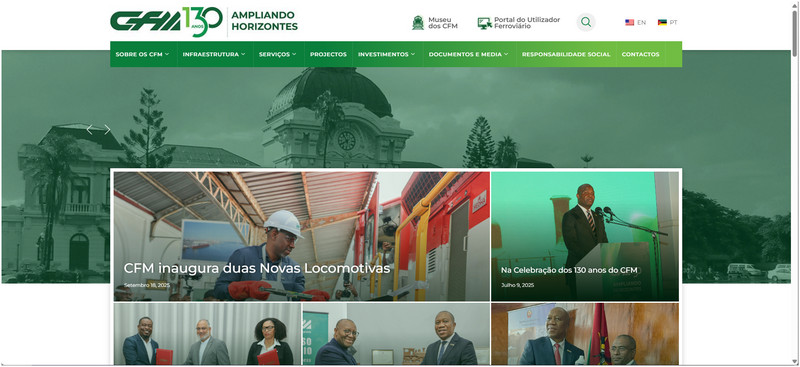Mozambique Railway Network
Mozambique's Railway Network: Infrastructure, Routes, and Economic Impact

Overview of Mozambique's Railway Network
Mozambique's railway network serves as a crucial component of the nation's transportation infrastructure, facilitating the connection between major ports and inland regions, and providing vital links to neighboring countries. This interconnected system plays a key role in the movement of goods—particularly minerals and agricultural products—as well as passenger transport. Spanning approximately 3,100 kilometers across the three economic corridors of Maputo in the south, Beira in the center, and Nacala in the north, the railway network significantly supports trade and economic integration within Southern Africa.
Historical Background
The origins of Mozambique's railway network date back to the late 19th and early 20th centuries during the Portuguese colonial era. Today, it is managed by Portos e Caminhos de Ferro de Moçambique (CFM), the state-owned authority responsible for the ports and railways. The network comprises three semi-independent regional systems: CFM-South, CFM-Central, and CFM-North, each aligned with one of the country's major ports. These systems, however, remain unconnected due to their historical focus on serving specific colonial trade routes rather than forming a unified national railway. The railways throughout Mozambique operate on a 1,067 mm (Cape gauge) track—a standard gauge in Southern Africa, which ensures compatibility with rail systems in neighboring countries, including South Africa, Zimbabwe, and Malawi.
Current Infrastructure and Operations
In terms of infrastructure, Mozambique's railway network includes approximately 3,100 kilometers of operational and partially operational lines. Some sections remain under rehabilitation or have been abandoned, stemming from the devastation caused by the Mozambican Civil War from 1977 to 1992. The rolling stock currently in operation is limited and aging. As of 2023, CFM-South operates 20 locomotives, CFM-Central operates 15, and CFM-North operates 25. Although there have been recent acquisitions, including 10 new diesel locomotives for CFM-South in 2020, the entire rail network relies solely on diesel power, which increases overall operational costs. Maintenance of the network varies significantly by region, with CFM-South benefiting from public-private partnerships that facilitate upgrades. Conversely, CFM-Central and CFM-North face delays largely due to ongoing funding constraints. Notably, freight capacity dominates the services offered, as freight trains primarily transport coal, minerals, agricultural products, and containers, while passenger services are limited mainly to suburban routes like Maputo to Matola and Beira to Dondo.
Impact of the Civil War
The destruction caused by the civil war led to a drastic reduction in operational capacity—down to about 20% by 1992. However, post-war reconstruction efforts have gradually restored critical rail lines with support from international donors, such as the World Bank and the Japan International Cooperation Agency (JICA), along with private investors. Despite these efforts, certain lines, including the Gaza and Zambezia railways, remain either non-operational or underutilized.
Economic Corridors of Mozambique's Railway Network
Mozambique's railway network is categorized into three major economic corridors, each anchored by a significant port and extending regions inland or connecting to neighboring countries.
- The CFM-South Corridor: Known as the Maputo Corridor, it connects the Port of Maputo to South Africa's Gauteng, Mpumalanga, and Limpopo provinces, as well as to Eswatini. Major routes include the Ressano Garcia line, which runs from Maputo to Ressano Garcia on the South African border, extending further into Pretoria and Johannesburg. The Limpopo Line facilitates trade with Zimbabwe by linking Maputo to Chicualacuala, while the Goba Line connects Maputo with Eswatini.
- The Beira Corridor: Also known as CFM-Central, this corridor links the Port of Beira to Zimbabwe, Malawi, Zambia, Botswana, and the Democratic Republic of Congo. Key routes here include the Beira-Bulawayo line, which connects Beira to Mutare in Zimbabwe, and the Sena Line, which serves the coalfields in Moatize.
- The Nacala Corridor: Referred to as CFM-North, it connects the Port of Nacala to Mozambique's Tete Province and extends to Malawi and Zambia. The Nacala Railway serves as the main route, connecting Moatize to Nacala via a network that includes several regional towns.
Operational Status of the Corridors
- Maputo Corridor: The Maputo Corridor is fully operational, having been rehabilitated post-1992 with investments from both South African and Mozambican sources. The corridor handles approximately 10 million tons of freight annually, transporting commodities such as chrome, sugar, and containers. Passenger services on the corridor are limited, primarily serving suburban routes, but they significantly contribute to the overall functionality of the network. This corridor plays an essential economic role by serving South Africa's industrial hub and supporting southern Mozambique's agricultural exports. However, it faces challenges such as delays at the Ressano Garcia border and competition from South African ports like Durban.
- Beira Corridor: The Beira-Bulawayo line is operational and benefited from rehabilitation in 2005, while the Sena Line underwent significant rebuilding by 2017, increasing its capacity to 6.5 million tons of coal annually with plans to further expand. This corridor plays a critical economic role, facilitating coal exports and allowing agricultural goods to flow from Malawi and trade with Zimbabwe. Challenges associated with the Beira Corridor include the damages inflicted by Cyclone Idai in 2019, which disrupted rail operations, and the need for infrastructure upgrades on Malawi's rail link. Some coal traffic has begun to shift toward the Nacala Corridor, further complicating logistics in the region.
- Nacala Corridor: The Nacala Railway has undergone significant updates and enhancements through investments from Vale Moçambique, amounting to $1.7 billion. With its current focus on coal exports, the Nacala Railway handles 2 million tons of cargo annually, including freight such as cotton and tobacco, although passenger services remain nonexistent. However, similar to the other corridors, the Nacala Corridor faces challenges, particularly related to security issues due to insurgency activities in Cabo Delgado, which have disrupted operations. High maintenance costs and a limited focus on non-coal freight activities also pose barriers to diversifying the corridor's economic contributions.
Summary
In summary, Mozambique's railway network plays an integral role in its economic landscape, supporting trade, resource extraction, and enhancing connectivity both within the country and with neighboring regions. The rail systems transport approximately 15 million tons of freight annually, with each corridor contributing significantly to overall trade volumes. However, challenges persist in the form of infrastructure gaps, climate vulnerabilities, and financing constraints, which necessitate strategic investments and cooperative efforts. Recent developments, such as modernization initiatives in Nacala and proposed expansions to the Sena line, reflect a commitment to improving railway efficiency and addressing these challenges. With continued focus on logistical improvements, security enhancements, and infrastructure upgrades, Mozambique can enhance the performance of its railway network, fostering economic growth and regional integration in Southern Africa.

.
Southern Mozambique Railways: Goba, Limpopo & Ressano Garcia Lines
Mozambique's southern railway system spans key corridors connecting Maputo with Eswatini, Zimbabwe, and South Africa. It includes three major lines:
-
Goba Line (467 km): Connects Maputo to Matsifa in Eswatini, transporting 780,000 tons of cargo and 3 million passengers annually. Operational since 1912, it was modernized in 2022 with border removal to streamline trade.
-
Limpopo Line (900 km): Links Maputo to Samabula, Zimbabwe. Built along the Incomati and Limpopo rivers since 1914, it faced setbacks during the civil war but was restored in the 1990s and 2004.
-
Ressano Garcia Line (88 km): Connects Maputo to South Africa. Modernization efforts, including a €93.3 million investment, have increased freight capacity from 13 to 24 million tons per year.
Together, these lines facilitate regional trade, support both freight and passenger transport, and strengthen economic integration in southern Africa. Despite historical challenges such as war and natural disasters, continued investments ensure the network remains a cornerstone of Mozambique's infrastructure and international trade.
Mozambique's Central Railway Network is a key component of the Beira corridor
Mozambique's Central Railway Network is a key component of Southern Africa's transport infrastructure, linking the ports of Bara, Maputo, and Nacala with neighboring countries: Zimbabwe, Malawi, Zambia, and Botswana.
Key Lines:
-
Machipanda (Bara-Bulawayo) Line: 880 km, connecting Bara to Zimbabwe via Mutare, transporting coal, agricultural products, and general cargo, with passenger services. A $6.5B transnational railway is planned to extend to Botswana, boosting mineral exports.
-
Senna/Central Line: 660 km, connecting Bara to Malawi and inland hubs like Mai, supporting freight and passenger transport. Restoration projects since 2006 have increased coal export capacity fourfold.
Future Projects:
-
Mutare-Bangula Link: 115 km connecting Mozambique and Malawi, reducing road reliance and opening new export routes for sugar, fuel, and other goods.
-
Bara-Botswana Railway: 1,700 km transnational line to a deepwater port at Tecoan, unlocking trade for landlocked nations.
The Central Railway Network strengthens regional trade, supports economic growth, and helps landlocked countries access ports efficiently, highlighting Mozambique's role as a transport hub in Southern Africa.
Mozambique's Northern Railway Network, the Nakala Corridor
Mozambique's Northern Railway Network, also known as the Nakala Corridor, is a key trade and transport route linking inland Mozambique and Malawi to the deepwater port of Nakala. Spanning 912 km, it primarily transports coal from the Mai mine in Tete Province to the port, passing through cities such as Nula, Kumba, Nikaya, and Motise.
Key Extensions:
-
Kumba-Lichinga Branch: 262 km, serving regional passenger and freight needs.
-
Nikaya-Chipata Line: Crosses into Malawi and Zambia, enhancing regional trade.
Historical Background:
-
Construction began in 1915, expanded to Malawi by 1970, and became a major export corridor.
-
Operations were halted during the Mozambican Civil War in 1984.
-
Rehabilitation efforts from 2005 culminated in a fully revived corridor by 2017, including a coal export terminal at Nakala Velha.
Current Status and Future Prospects:
-
The corridor now supports up to 18 million tons of coal annually.
-
Plans by the Zambia Railways Board and Mozambique aim to further enhance trade, connectivity, and freight efficiency.
The Nakala Corridor is a strategic artery fostering regional integration, economic growth, and export capacity across Mozambique, Malawi, Zambia, and beyond.

